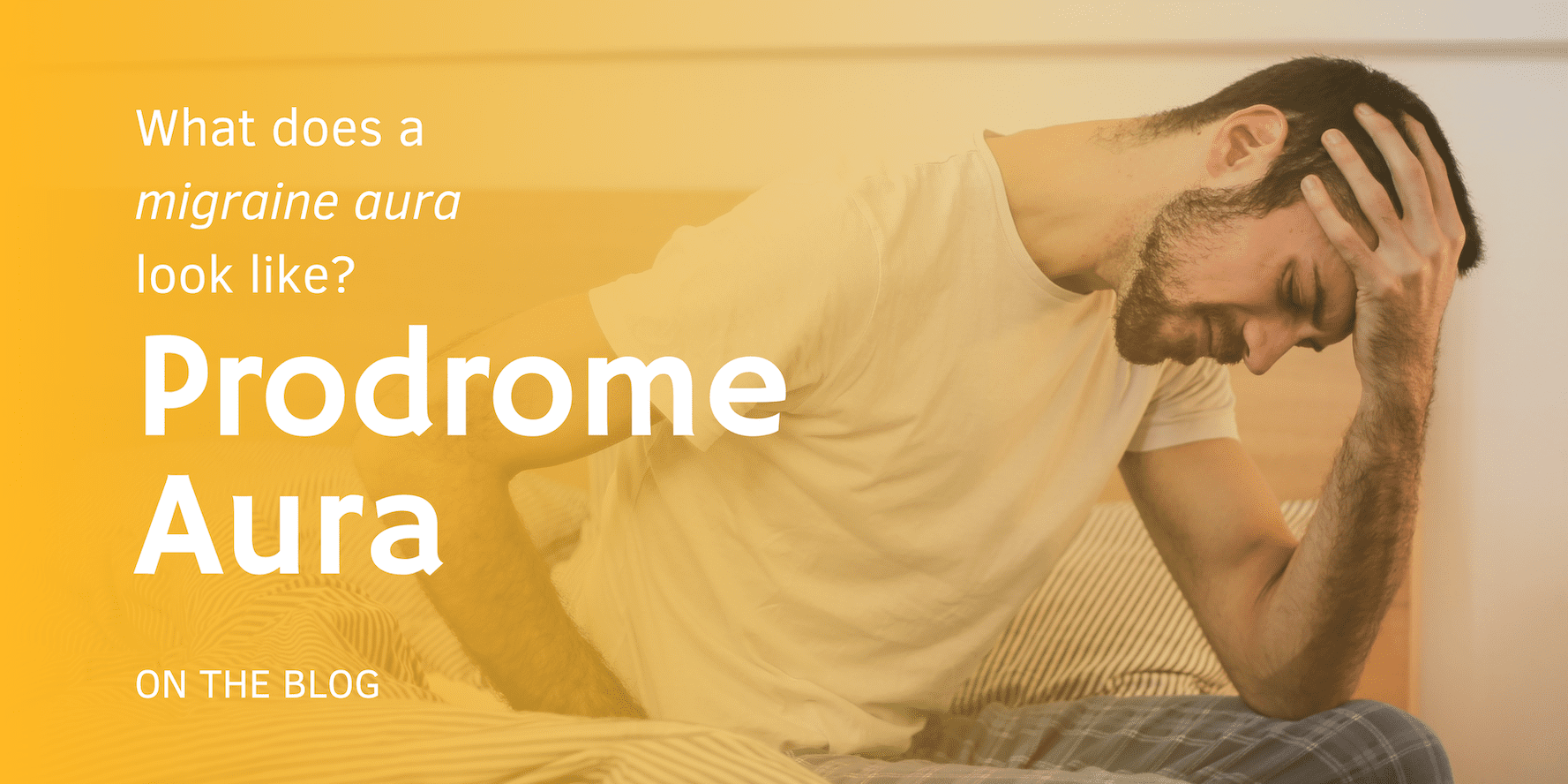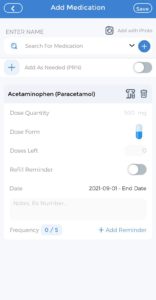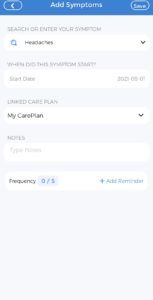
Prior to the headache, a premonitory phase, known as a prodrome aura, can mark the beginning of a migraine attack. Following this, a natural alert known as an aura allows you to detect that a migraine is about to hit.
A cephalgia, most commonly known as a headache, describes a symptom that is characterized by pain in the head. This pain can cause pressure and aching that can extend to the neck and upper back. The pain from headaches can range from mild to severe. They usually occur on all sides of the head, which is a characteristic that distinguishes it from a migraine. There are various classifications of cephalgias, which can also be categorized as either primary or secondary.
This article will provide you with the resources to detect a prodrome aura. It will assist you in better understanding the risk factors and general management of cephalgias and migraines. Having the all-in-one app CareClinic app will help you track your symptoms and manage your migraine attacks to better cope with them.
Classification of Cephalgias
A primary cephalgia refers to a headache that is not due to an underlying condition. Primary cephalgias are therefore not considered dangerous. Under primary headaches, you could have migraine cephalgia, tension cephalgia, cluster cephalgia, hormonal cephalgia, and sinus cephalgia. On the other hand, secondary cephalgias refer to the type that accompanies an underlying condition. These can therefore be dangerous, depending on the severity of the condition.
Cluster cephalgia is characterized by severely painful headaches that occur in clusters on a particular side of the head. Whereas, Sinus cephalgia is one that occurs alongside a sinus infection with accompanying symptoms like a fever, cough and nasal congestion. Chiari cephalgia is a type that occurs due to the Chiari malformation that causes the skull to press onto the brain, resulting in a painful sensation. Nevertheless, tension cephalgias are mainly muscular and the most commonly occurring is the reason most people use over-the-counter drugs. Finally, thunderclap cephalgias develop within a minute and can be due to a subarachnoid hemorrhage, a stroke, or an aneurysm.
Downloading the CareClinic app will provide you with the resources that will allow you to better understand and classify your cephalgia.
Stages of a Migraine
A migraine is divided into various stages such as prodrome, aura, attack, and postdrome. The prodrome phase is the initial phase occurring from a few hours to days with various behavioural symptoms. Aura is the phase occurring from around 5 to 60 minutes with various neurological symptoms. The headache phase occurs between 4-72 hours, where the pain is really felt to the peak, and the postdrome phase occurs after the peak of the headache.
Signs of a Cephalgia Versus a Migraine
From the various types of cephalgias, an individual can easily differentiate between the different classifications. The symptom that is common to all types is experiencing pain in the head, neck, and face. The intensity varies across conditions and can also have an increase in frequency over time. On the other hand, migraines have a much more constant severity in intensity. They have the ability to weaken the patient. However, some migraines called silent migraines are not associated with any pain.
Migraines are a form of severe cephalgias and often have other symptoms that accompany the pain in the head. They are a disorder of recurrent attacks, which come and go. Migraines are gradual in onset and are mostly unilateral, with an increase in intensity and frequency that last about 4-72 hours. These symptoms include; nausea, vomiting, pain in the temples, temporary vision loss, and pain behind one eye or ear. The pain from a migraine can be moderate to severe, causing most people to seek help from a doctor. Various types of migraines are differentiated by whether they have an aura or not and whether they involve sensory changes. This brings the classification to two major groups; a migraine with an aura and a migraine without aura.
What is an Aura?
Migraines that are accompanied by an aura involve a period of disturbance of the senses in the early periods serving as a warning of an approaching headache. It can include seeing zigzag lines of light, having blind spots in the vision, feelings of pin and needles in the arm or leg, and weakness in the shoulders and limbs. On the other hand, a migraine without an aura lacks the sensory disturbance before the onset of the migraine. Other types of headaches include menstrual migraines occurring during the menstrual cycle, chronic migraine lasting for over fifteen days per month, and abdominal migraine that is due to improper working of the digestive tract, a vestibular migraine that is characterized by severe vertigo, and a basilar migraine that causes disturbance of neurological functions.
Migraine Auras
A migraine aura refers to a period before the migraine itself that is characterized by sensory disturbance and accompanied by various signs and symptoms. It serves as a warning of an impending migraine and is seen in about one-quarter to one-third of the people with migraines. The changes experienced in the different senses can start gradually and extend to about five to sixty minutes. The significant effect is the visual disturbance that can subject the individual to seeing a dark spot, zigzag lines in their vision, blurry vision, sparkling lights, and temporary loss of vision. There can also be sensory disturbances like numbness and tingling in the extremities.
Apart from that, they may also experience disturbances in speech and language comprehension and loss of taste and smell. The symptoms are seen in the aura stage before the attack stage can be explained by focal cortical activity. There can be chemical imbalances in the brain that are present in migraine attacks. Sometimes, the aura may occur without the headache, causing the symptoms to affect the individual still. Not all persons with migraines experience auras. Only about 15-20% of those with migraines experience auras and these symptoms can be tracked on the CareClinic symptom tracker section.
Prodrome Aura
The prodrome aura stage is the first stage in the onset of migraines that occurs about 1-2 days before the migraine headache attack. It involves a group of signs that can serve as a warning sign hours to days before the real attack and is also called the premonitory or the warning phase. It lasts between a few hours to days. If keen enough, most people are able to pick out this prodrome stage and try to curb the problem early before getting to the headache stage. This can be done by the use of medication, relaxation therapy, acupuncture, and dealing with the triggers of the migraine.
The prodrome aura phase is a phase with various symptoms, including Changes in bowel habits like constipation and diarrhea; mood changes like anxiety; irritability and depression; muscle cramps and muscle stiffness; increase in urinary frequency; food cravings primarily for sweets; yawning excessively; sensitivity to sound and photophobia. The prodrome aura stage can be a good point to stop the progression into the headache attack stage by detecting the signs and symptoms.
What Makes the Prodrome Aura Worst?
The prodrome aura stage is a very crucial stage due to the various behavioral and sensory changes observed. If not handled cautiously, it can lead to the deterioration of the individual’s health and generally affect the standard of life. There are various things that make it worse, such as the persistence of triggers. If the affected individual does not stop the trigger that caused the prodrome, the migraine will worsen. Secondly, failure to take medications can also subject the individual to worse symptoms. Therefore, this can be considered the most crucial stage as all of the other stages emerge according to the precautions taken during this phase.
Treatments and Prevention of the Prodrome Aura Stage
The first way to try and prevent the prodrome aura stage is by keenly noting the different triggers that activate it. This could range from hormones to stress to specific foods and drinks. After doing this, the individual can then choose to avoid the triggers to avoid the conception of the stage in the first place. After its occurrence, one can start treatments like triptans that can stop a migraine episode. The treatments have proved to be more effective once started early than waiting until the progression of the attack and the worsening of symptoms.
Keep track of the triggers that activate the prodrome aura stage for you by using the CareClinic features and get started on your treatment journey! CareClinic provides you with the opportunity to assess your progression and be up to date with your results.
Understanding the Difference Between an Aura and Prodrome
Even though both of these stages occur before the headache attack stage, the aura and prodrome phase can be distinguished from each other. The prodrome phase is usually the first stage occurring between a few hours to days, while the aura stage occurs from between 5 to 60 minutes before the headache. The aura results from focal activity while prodrome is linked to interactions of various regions in the central nervous system. Nevertheless, the aura characteristics are mainly sensory, while the prodrome characteristics are primarily behavioral. This makes it easy to term the symptoms in the prodrome stage as triggers. For example, at least one-third of the people complain of light exposure triggering their attacks while in a prodrome aura.
It is possible that there can be an overlap in the symptoms observed during the different stages of the migraine, but there are others that can only be seen for the prodrome stage. These symptoms include excessive yawning, urinary frequency, and changes in bowel movement, including constipation or diarrhea. The prodrome stage might be considered to be the worst. This is because of its effects that produce changes in various central nervous system regions. The symptoms that it produces are primarily behavioral and can therefore affect the individual severely. It is also the first stage and therefore has the capability of advancing to the aura and headache stage if not treated on time.
How does a Migraine Aura Feel?
The migraine aura is the second stage after the prodrome stage. Even though it does not occur in every person who experiences a migraine, it is a crucial stage where medications and different actions can be implemented to stop it from progressing into the headache stage. For those with an aura, the headache is accompanied by various neurological symptoms like speech impairment, hearing disturbances, mobility defects, weakness and paralysis, pins and needles sensations in the arm or leg. In addition, there can be changes in vision like flickering, inability to clearly focus on objects, and hallucinations. Other language problems include confusion, decreased concentration and trouble incomprehension.
Dangers of a Prodrome Aura
A migraine aura is not in itself considered dangerous. However, if the symptoms start to increase in intensity or begin to persist, it is vital to seek help from a doctor. Since the effects observed are mainly linked to the focal impacts in the brain, persistence can mean that there can be harm imposed on a brain region. A person could end up with vision, hearing, or even locomotion problems. It is therefore advisable to try and treat it before it progresses any further.
Triggers for a Migraine Prodrome Aura

Triggers are the factors that predispose an individual to experience a particular condition. There are various factors that can cause an individual to get a prodrome aura. They can be hormonal during the menstrual cycle or experience emotional triggers like anxiety, depression, and stress. The consumption of alcohol, cheese, chocolate, medications like some birth control pills, and hormone replacement therapy can act as triggers as too. Finally, there can be environmental factors like temperature changes, bright light and loud noises that can trigger the migraine aura. Other triggers include; vigorous exercise, insufficient sleep and irregular meals. Therefore when the triggers are curbed on time, it can help ensure that the aura does not progress to the headache stage of the migraine.
Headache Stage
This is the second last stage of the migraine occurring after the prodrome aura phase, also called the Migraine Attack Stage. This is characterized as one-sided pain that has the ability to radiate to the opposite side and become bilateral. It has a stabbing or throbbing sensation and can increase in intensity from moderate to severe. This pain can last between 4 to 72 hours and has been noted to be worsened by physical activity or strenuous activity in general. Once the pain exceeds 72 hours it becomes a medical emergency. It can also be accompanied by other symptoms like light sensitivity, visual and auditory problems, and vomiting. Most affected individuals choose to be alone in a dark and quiet room, which has been said to help alleviate symptoms.
Postdrome Stage
Postdrome is the last stage after the attack phase, also known as the post headache or recovery phase. It takes around 24-48 hours and is accompanied by symptoms of a “hangover.” The hangover is mostly attributed to the medications taken between the migraines to get rid of the pain. The common symptoms experienced during postdrome include fatigue, body aches, confusion, and reduced concentration. During this phase, the pain lessens, and signs of euphoria can be noted. However, postdrome, along with the prodrome aura, does not occur in everyone and can vary in the symptoms expressed.
Preventive Treatments of Cephalgia & Migraines
 There are various methods of prevention and treatments that can alleviate the painful symptoms of a headache. These include: placing a cold towel on the head, moving into a poorly lit or dark room with no noise, reducing triggers like anxiety, fatigue, and stress. One can also start taking medications for treatment. An individual can use painkillers like acetaminophen. NSAIDs like ibuprofen, and triptans to relieve the symptoms and thus reduce the severity of the migraine attack. Other alternatives include acupuncture and relaxation.
There are various methods of prevention and treatments that can alleviate the painful symptoms of a headache. These include: placing a cold towel on the head, moving into a poorly lit or dark room with no noise, reducing triggers like anxiety, fatigue, and stress. One can also start taking medications for treatment. An individual can use painkillers like acetaminophen. NSAIDs like ibuprofen, and triptans to relieve the symptoms and thus reduce the severity of the migraine attack. Other alternatives include acupuncture and relaxation.
Lifestyle modifications are essential in the prevention of cephalgias and migraines. This can include avoiding skipping meals, eating healthy, adequate rest, developing a fixed circadian cycle, and regular exercise are important in the prevention.
In conclusion, cephalgias and migraines are common sensations in our day-to-day lives. Triggers that produce them range from physiological stress, lifestyle, and diet to underlying disease. Understanding the triggers, changing our lifestyle, and seeking interventions, are among the few ways we can reduce the effects they have on our quality of life. Each individual should work on understanding the different stages from prodrome to the postdrome and how to curb them.
Leveraging Digital Health to Track Symptoms of a Prodrome Aura

One of the easiest ways to track your headache symptoms and create a prevention plan is by using CareClinic. Track your symptoms by using the symptom tracker on the care clinic app. Use the drop-down menu to include any pre-existing symptoms that are included in the app! This allows you to also add notes to your symptoms about details that you believe are important. Nevertheless, it can help track the frequency of your symptoms.
CareClinic has a check-in section that includes diary entries that can help track your treatment and prevention journey. This allows you to maintain a schedule to ensure you are doing your best to help heal your condition. You can use the diary or reminders option to stay on track with your medications. Using CareClinic, you can also include entries on how your progression has improved your day-to-day performance. Are the medications helping you? Which one relieves your symptoms the most?
Nevertheless, CareClinic also provides you with reports to update you on the progress of your journey. This gives you detailed information on your symptom tracking and an overview of the improvement of your health.
Moving Forward From a Prodrome Aura
Do not let your migraines consume you. It can often take time and practice to be able to detect prodrome auras. Detecting a prodrome aura is important in preventing the oncoming stages of a migraine. One of the easiest ways to track your symptoms and create a detection and prevention plan is by using CareClinic. CareClinic also provides you with reports to update you on the progress of your journey. This gives you detailed information on your symptom tracking and an overview of the improvement of your health.


